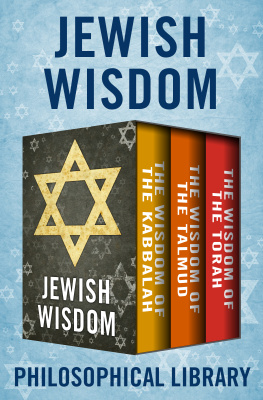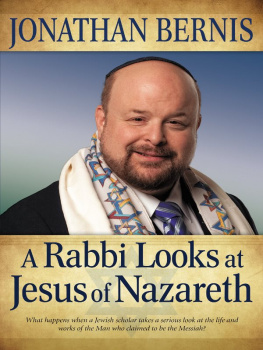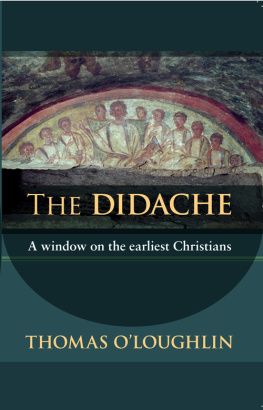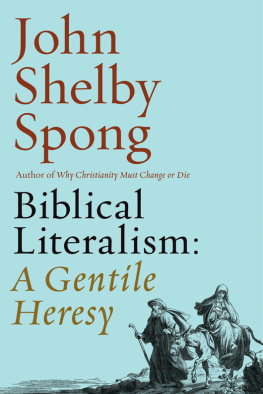T he following study is a slight revision of my doctoral dissertation, Didache, Torah, and the Gentile Mission: A Mediation of Torah for the Church, which was accepted by the Department of Theology and Religion at the University of Exeter in 2019 . Importantly, by studying the Didache, I had the opportunity to research Second Temple Judaism, the Dead Sea Scrolls, both the Hebrew Bible and New Testament, nascent Christianity, and Christian Judaism.
While having the good fortune of living in London during the beginning of my studies at the university, I made frequent trips by train to Exeter and back, usually revising my German on the way. At Exeter, I had an extraordinary supervisor and mentor in Dr. David Horrell, Professor of New Testament Studies, who was unfailingly perceptive, challenging, helpful, and patient. Without his help and direction this work may not have come to fruition. We met both at Exeter and, later on, at various annual meetings of the Society of Biblical Literature. I always went away with much to think about, and reasons to refine my argument. My second supervisor, Dr. Siam Bhayro, also made a number of valuable contributions and largely stimulated my investigation into the social situation of the Antiochene community against the background of the Jewish conflicts with Rome.
Another good fortune was my proximity to Tyndale House in Cambridge. While fifty miles away, it could be reached within ninety minutes by car, and proved to be a life saver with its comprehensive resources and warm, studious atmosphere. An hour spent there was equivalent to at least two elsewhere, making it well worth the drive. There I made friends with Dr. Stefan Bosman, a fellow student, and had stimulating interactions with scholars from around the world. In addition I am grateful for the encouragement of Dr. Mitch Glaser and my friend Bernard Miel.
I cant begin to thank my wife Deborah enough, as in some ways she bore the brunt of my studies, and all with good grace. She is an eshet chayil , a woman of valor. My aunt Joyce regularly welcomed me into her home opposite Exeter Central station, and one of the joys of my study was getting to know her better. My parents, Elie and Judith, were also a great inspiration, both in my fathers example of studiousness and my mothers warmth and encouragement. My employer Chosen People Ministries, and many financial supporters through it, also were key in making my studies possible, including two short sabbaticals that helped push my work forward.
Not to be facetious, I am grateful to the good scribe Leon, who transcribed the Didache in 1056 , and no less the constellation of tremendous Didache scholars who have gone before, too many to mention. I think Leon would have been pleased with most of them. Now, thanks to the graces of Wipf and Stock Publishers, I am also grateful for their assistance in making this work widely available.
Abbreviations
QpHabDSS, A Commentary on Habakkuk
ACOApostolic Church Order (=Ecclesiastical Canons; Kirchordnung )
ANF Ante-Nicene Fathers ( 1994 ) Roberts and Donaldson, eds.
Ann. Tacitus, The Annals
Ant. Josephus, Antiquities of the Jews
Apost. Con.Apostolic Constitutions
BHSBiblia Hebraica Stuttgartensia
Der. Er. Zu.Derek Ere Zua
DSSDead Sea Scrolls
Clem. Recog. Clementine Recognitions
Doct. apost.Doctrina apostolorum
Did. apost. Didascalia apostolorum
Ep. fest . Epistulae festales (Athanasius)
Ep. Pet. to Jas. Pseudo-Clement, Epistle of Peter to James
EpitomeEpitome of the Eighth Book of the Apostolic Constitutions
fol(s)folio(s)
GTWGreek Two Ways
HCodex Hierosolymitanus (=H)
Hist. eccl. Eusebius, Ecclesiastical History
Ign. Magn .Ignatius, To the Magnesians
Ign. Phld .Ignatius, To the Philadelphians
Ign. Smyrn Ignatius, To the Smyrneans
War .Josephus, Jewish War
JTS Journal of Theological Studies
P.Oxy. 1782 Oxyrhynchus Papyrus 1782
SBLSociety of Biblical Literature
SerekSerek Hayaad (=QS, =Manual of Discipline, Community Rule).
Strom. Clement of Alexandria, Stromateis
Suet. Claud. Suetonius, Lives of the Caesars, Deified Claudius
Suet . Tib. Suetonius, Lives of the Caesars, Deified Tiberius
Xen. Mem. Xenophon, Memorabilia
Quis div.Quis dives salvetur (Clement of Alexandria)
Xen. Mem. Xenophon, Memorabilia
Introduction
Abstract
T he Didache was written for a church enduring internal and external social and political stresses. In this environment it sought to establish norms for the individual and the community. Long looked to for insights into the life of the early church, the Didaches reception of the Torah has received significant passing attention, but has never benefitted from an extended systematic analysis. Well received in the early church, it reflects both a first-century and Antiochene provenance.
It is specifically in the context of its Two Ways teaching that the Didache adopted an established topos rooted in both the Torah and other traditions, accessible to Jew and gentile alike, to convey its teaching on the Torah. This teaching was established on the basis of the presumed authority of religious teachers and specifically that of Jesus himself.
On the basis of this assumed authority, the Didache mandated the Way of Life for Christian disciples, laying the foundations of its approach with the double command to love God and neighbor, reflective of the Decalogue, the two tables of the Torah. Tightly bound structurally and thematically to the following Two Ways, the sectio evangelica, a key section comprising known Jesus sayings, shows an affinity to Torah-affirming passages in the Gospels. As a prologue that bears comparison to the Two Ways yoke of the Lord epilogue, it places stress on the Torah as mediated by Jesus.
Within the Two Ways material itself, there is not only a marked structure revolving around the second table of the Decalogue, but a series of textual markers linking and equating it in some ways to the Torah as a whole. In this context, its endorsement of the yoke of the Lord is a striking Torah affirmative statement which reinforces the commitment to the Didaches teaching that is required of it.
It is this commitment to the Torah as applicable to all Christians that is enjoined upon the gentile disciple; the Torah presented in those respects that were deemed to apply to gentiles. Acceptance of this sine qua non formed the basis for induction into the church and participation in its eschatological hope.
The Didache is one of the oldest non-canonical documents of the early Jesus movement. It addressed a small but rapidly expanding community in an age of socio-political crisis. Composed in Antioch and written from within a Christian-Jewish milieu, its intended audience was primarily gentile. While attention has naturally been paid to the Jewish sources of the Didache, questions remain concerning its underlying presuppositions regarding the enduring validity, applicability, and authority of the Torah, particularly in regards to its gentile Christian recipients.
A constellation of issues remain to be resolved in Didache studies, and an accurate understanding of the role of the Torah in the Didache is a significant, if not the key, factor in many of these. The question as to whether the Didache may have implicitly or overtly sanctioned and advocated conversion to Judaism remains viable for a minority of scholars. Even more, there is the broader issue as to whether the Didache mandates Torah observance for its recipients. While having been partly addressed in a number of papers and short studies, the Didaches reception of the Torah has not been given sufficient attention nor been sufficiently examined, and this study attempts to address that situation.













